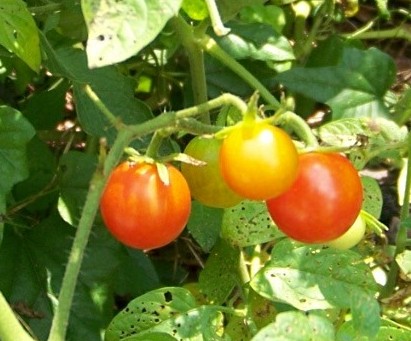| Gardens Ablaze | ||
|
|
Tomatoes
|
|
|
Related Tomato Topics Tomato Problems - Pests and Diseases Detailed Vegetable Profiles Site Map
Home
|
There are four basic types of tomatoes, grouped by size: The Smallest tomatoes are the Cherry Tomatoes, including Sweet 100 and Small Fry. They form large clusters of fruit and grow vigorously, and they are sweet and tasty. Medium tomatoes include Early Girl and Better Boy. These are tasty tomatoes, and are some of the earliest to set fruit. Most make excellent slicing tomatoes. Plum tomatoes include Roma and Chico III. They have thick walls and fewer seeds than the other tomato categories, making them excellent choices for tomato-based sauces. Beefsteaks are the largest varieties, and include Beefmaster and Bush Beefsteak. These are large, tasty, and firm, and make excellent slicing tomatoes. Tomatoes can also be grouped by their growth habits: Indeterminate tomatoes are the ones that send up vigorous vines. The earliest tomatoes are of this variety. These need to be staked or caged to keep the plants healthy and the fruits clean. Determinate plants are the bush varieties and are good choices for containers and small spaces. When starting a tomato garden, choose seeds or starts with V, F, N, S, and C behind the variety name to ensure that the tomatoes will resist known tomato problems. V=Verticillium Wilt, F=Fusarium Wilt, N=Nematodes, S=Stemphnylium, and C=Cladosporium. Most tomato plants will survive and produce fruit even in sub-standard soils and conditions, but to achieve the biggest fruits and best health for the plants, careful soil preparation is a must. Till or double-dig the bed and add compost, manure, and maybe some 10-10-10 fertilizer before sowing the seed or planting the seedlings, and you will be rewarded with a bumper crop of good-looking and good tasting fruits. Some species do better in the north, and some do better in the south, so choose your varieties carefully. Generally, though, if they are selling it locally it is a variety that will do well locally. Most tomatoes require a long growing season, so start seeds in flats eight weeks before the last frost date. Alternatively you can just buy seedlings from a local source, but be sure to plant them after the last frost. Choose healthy-looking plants with strong stems and green leaves. If a surprise frost does come along after they are in the ground, use a cover of some sort to protect them. Tomatoes need plentiful sunshine, so be sure to give them a sunny space in the garden. Planting nasturtiums or marigolds nearby will attract beneficial insects that eat tomato enemies. See the Companion Planting Charts for more information on this. Common problems with growing tomatoes include split skins (due to uneven watering - a good soil should help here), and skin imperfections (due to temperature variations). Try to protect the plants from excessive wind and heat if possible. Skin imperfections do not affect the taste of the tomato. Other tomato problems include blossom end rot, where the bottom of the fruit turns brown and leathery. This is caused by moisture fluctuation and calcium deficiencies (back to good soil). Blight is another common problem, where the leaves turn brown and the stems turn black. This happens during unusually wet summers or can be caused by planting the plants in the same place for consecutive years. Do rotate your crops yearly. Holes in the fruit may indicate tomato hornworms. - these are huge caterpillars with voracious appetites that can devour a plant very quickly. Hand pick these and move them far away if you find them. For the best taste, ripen tomatoes on the vine. When ready, they will pull easily from the vine. Ripen green tomatoes at the end of the season by putting them next to bananas or apples, which contain properties that will help the tomato to turn red more quickly. Medicinal Properties: Tomatoes contain calcium and vitamin C, to name just two of their beneficial properties. A study done recently found that people in Northern Italy who ate 7 or more servings of raw tomato per week had up to 60% less chance of developing colon, rectal, or stomach cancers compared to individuals who ate two servings or less. There are also indications that tomatoes may play a role in prevention of heart disease, high cholesterol, and fatty deposits in the arteries, and that as little as two glasses of tomato juice per day can be very beneficial in preventing these problems. Because of storage and large-scale growing issues, tomatoes are still subject to varying degrees of chemicals and pesticides, so if contemplating a self-medication plan involving tomatoes, it is suggested that you grow your own organically or buy certified organic products to circumvent the pesticide issue entirely, but if this is not possible, the grocery store variety will do in a pinch. More information on Tomatoes
is available in the Gardening QA Section.
Click here
to see what other gardeners are asking.
Custom Search
|
|
|
Gardens Ablaze |
||
 Tomatoes
are the most grown vegetable of them all in the home garden. They
are easy plants to grow, and provide good yields for the amount of space
they use. They are rich in many beneficial substances, and as such,
make a good addition to the healthful garden (See Medicinal Properties Below)
Tomatoes
are the most grown vegetable of them all in the home garden. They
are easy plants to grow, and provide good yields for the amount of space
they use. They are rich in many beneficial substances, and as such,
make a good addition to the healthful garden (See Medicinal Properties Below)